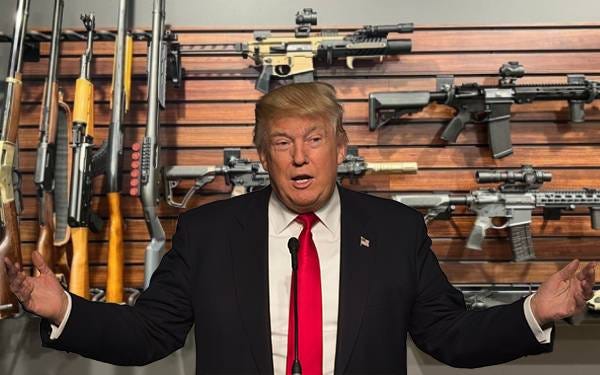Trump's obsession over border security doesn't include guns headed south
U.S. policy is inadvertently arming organizations it considers "terrorists" and driving violence in Latin America
Preventing migrants and fentanyl from crossing the U.S. border — by any means necessary — has been a priority of the administration of Donald Trump. Stopping the massive flow of weapons from the U.S. into Mexico and beyond that end up in the hands of criminal groups. and even organizations that the U.S. State Department considers “terrorists”, however, hasn’t even made the presidential agenda.
At least 74% of unregistered and illegal weapons in Mexico come from the United States, principally the states of Texas, Arizona, and California. According to the most recent report on the subject from the U.S Justice Department, the majority of these are bought by criminal groups in Latin America from Mexico to Colombia to Ecuador.
The U.S is exerting considerable pressure on Mexico to “secure the border”, a policy which in practice means that the White House is outsourcing their migration crackdowns to Mexico as well. Mexican President Claudia Sheinbaum has largely acquiesced. That hasn’t stopped Trump from imposing tariffs, such as a 17% surprise tax on tomatoes yesterday. He has also threatened in recent weeks to impose 30% blanket tariffs on all Mexican goods.
Yet the tidal wave of illegal guns flowing south — a dynamic that stretches back decades — continues unabated.
Earlier this year, the U.S. Supreme Court rejected a lawsuit filed by Mexico that aimed to hold top U.S. gun makers and distributors responsible for facilitating the flow of guns to Mexican drug cartels and the resulting violence.
A recent detailed investigation by academics and investigative journalists, however, first published at the Conversation, showed exactly how that illicit economy functions, and the simple answer is: drugs.
The summary of the report, which is well worth reading in its entirety, details investigations by the Bureau of Alcohol, Tobacco and Firearms (ATF), the FBI, and documents from the Department of Justice.
In addition to detailing the routes and methods by which guns move south from the U.S. into Mexico, investigators discovered a repeating and alarming pattern. Gun shipments are often a scheme to pay for drugs smuggled into the U.S. by the very cartels Donald Trump is so vocal about fighting.
For months, Trump has publicly mused over conducting U.S. military operations against cartels in Mexico. Earlier this year the U.S. State Department classified some organized crime groups in the country as “terrorist organizations.”
U.S. military operations against cartels on Mexican soil would be a terrible idea, for too many reasons than the PWS Dailies format allows.
U.S. drug, border, and migration policy, however, is inadvertently arming cartels instead.
In over 100 ATF cases detailed by investigators at the Conversation, nearly one-fifth explicitly mention drug trafficking in connection to the confiscated firearms.
Money laundering takes many complex forms, but for cartels shipping fentanyl, cocaine, or other substances north, it is often easier to receive firearms than money in return, particularly from a country where they are so readily available.
And those weapons, alongside U.S. policies that make drug-trafficking so lucrative, are one of the factors driving record violence in Mexico.
The ATF estimates that more than 135,000 firearms cross the southern U.S. border annually.
You can also donate a one-time gift via “Buy Me a Coffee”. It only takes a few moments, and you can do so here.
And if you can’t do any of that, please do help us by sharing the piece! Organic growth is what keeps our pirate ship afloat, and we can’t do it without you.
Hasta pronto, piratas!


